| Columns Retired Columns & Blogs |
One choice of filter, the MQA? No chance to use another type of filter if you tend to prefer it, like a linear phase one?
I measured Bel Canto Design's Black ACI 600 using my Audio Precision SYS2722 system (see the January 2008 "As We See It"). Usually, before I test an amplifier, I precondition it with both channels driving a 1kHz tone at one-third power into 8 ohms for an hour, but this is relevant only for an amplifier with a conventional output stage. As the ACI 600 uses class-D output modules, I began testing it soon after turning it on. However, as class-D amplifiers produce RF noise that could drive my analyzer's input circuitry into slew-rate limiting, I inserted, between the test load and the analyzer, Audio Precision's auxiliary AUX-0025 passive low-pass filter, which eliminates noise above 200kHz. Fort some tests, I also used the SYS2700's internal brickwall filter set to 20kHz, to ensure that my measurements were not being contaminated with noise above the audioband.
Looking first at the single-ended analog line inputs, the maximum voltage gain at 1kHz from the speaker terminals into 8 ohms, with the volume control set to the default maximum of "85," measured a low 19.1dB. There might be insufficient gain with low-output sources, but selecting a maximum volume of "100" with the onscreen menu increased the gain to 34.1dB. The Soft mute setting reduced the level by 10dB; the Mute was, of course, a full mute. It should be noted that with high-output sources, the analog inputs clipped at 2.375V. These inputs inverted absolute polarity, and the input impedance was a relatively low 11k ohms from 20Hz to 20kHz. I had some problems measuring the output at the rear-panel headphone jack, as I could get output only in the left channel. However, the headphone output impedance was low, at 21 ohms at all audio frequencies, and the output preserved absolute polarity (ie, was non-inverting).
The output impedance at the speaker terminals was 0.2 ohm at all audio frequencies; as a result, the modulation of the ACI 600's frequency response with our standard simulated loudspeaker was just ±0.2dB (fig.1, gray trace). The response is down by 1.5dB at 20kHz, and above that frequency it drops off rapidly into all impedances. There is also a slight channel imbalance, of 0.2dB. (Using the menu, I ensured that the balance was set to "0" before performing any measurements.) Without the auxiliary Audio Precision low-pass filter, the waveform of a 10kHz squarewave (fig.2) was obscured by HF noise. (With no signal present at the amplifier's input, I measured 390mV of noise with a center frequency of 433kHz.) With the AP filter (fig.3), the waveform's risetimes were increased by the ultrasonic rolloff seen in fig.1, and there is critically damped ringing on the leading edges, presumably due to the class-D module's output filter. The Bass EQ control (fig.4) shelved up or down the output below 120Hz by as much as 3dB, and the Tilt control hinged the response above and below 800Hz by up to the same 3dB (fig.5).
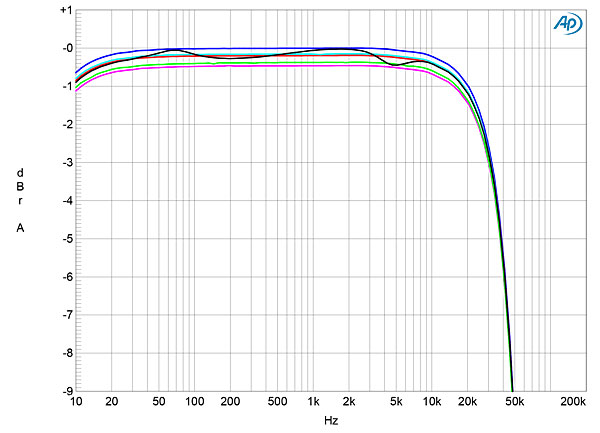
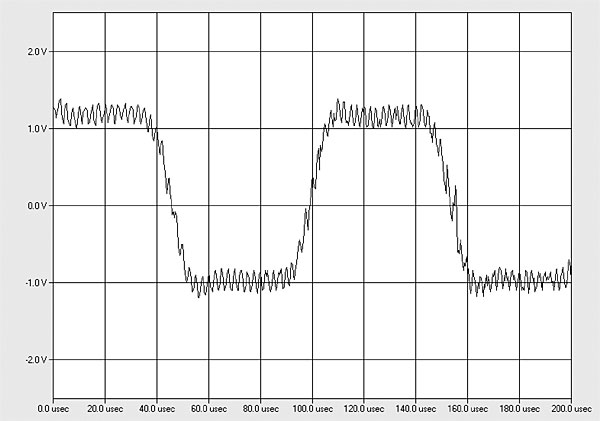
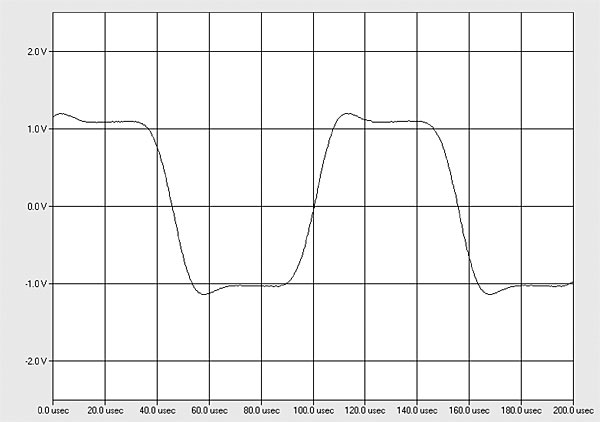
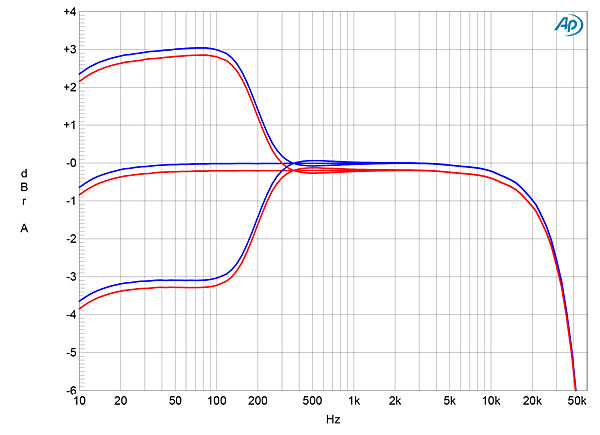
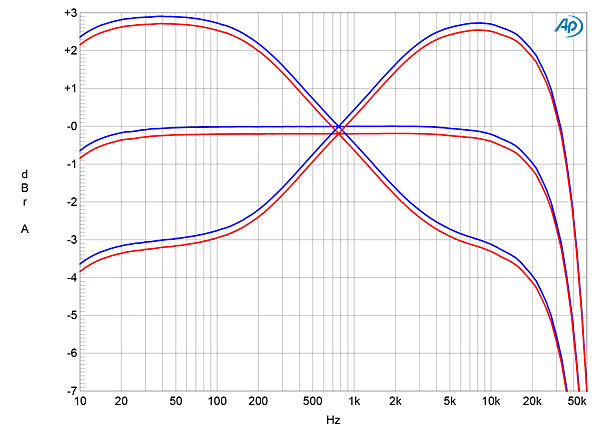
Channel separation was 100dB or greater below 1kHz, and still 70dB at the top of the audioband. The unweighted, wideband signal/noise ratio—taken with the AP auxiliary filter, the input shorted to ground, and the volume control set to "85"—was 68.5dB, this improving to a respectable 83dB when the measurement bandwidth was restricted to 22Hz–22kHz, and to 85.5dB with an A-weighting filter in circuit. Spectral analysis of the low-frequency noise floor (fig.6) indicated the presence of a 60Hz component at –95dB ref. 1W into 8 ohms, and that all other AC-supply harmonics lay below –100dB.
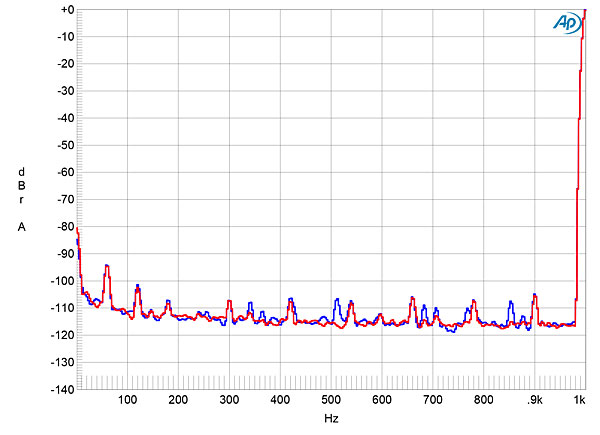
Figs. 7 and 8 show how the Black ACI 600's percentage of THD+noise varied with output power into 8 and 4 ohms, respectively. Actual distortion began to emerge from the noise floor at around 20W into both loads, but remained low in absolute terms until waveform clipping occurred. The Bel Canto is specified as offering 300Wpc into 8 ohms or 600Wpc into 4 ohms (both equivalent to 23.8dBW), but these graphs shows that while the ACI 600 with both channels driven exceeded its specified 8-ohm clipping power, at 320W (25.05dBW) it missed its 4-ohm power spec by just 0.2dB, delivering 515W at 1% THD+N.
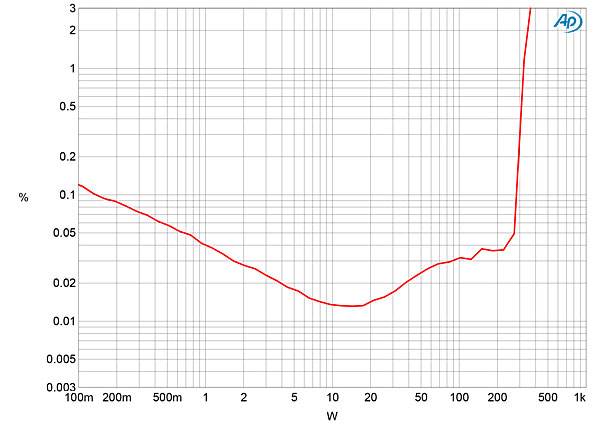
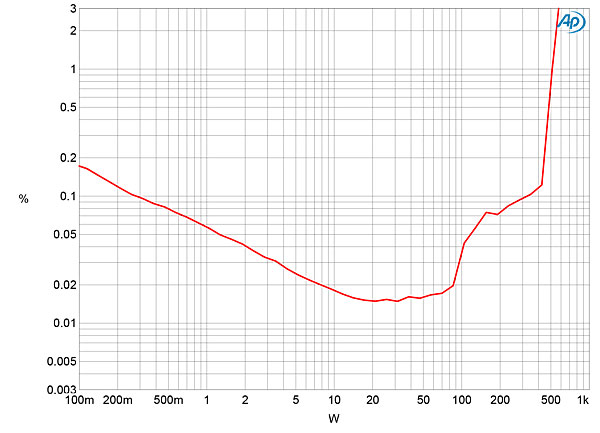
I measured how the ACI 600's THD+N varied with frequency at a level, 20V, where I could be sure I was looking at distortion rather than noise (fig.9). The THD was very low below 5kHz in both channels into 8 ohms (blue and red traces), but increased into 4 ohms, more in the right channel (magenta) than the left (cyan). The THD was higher into 2 ohms (gray). The distortion itself comprised the relatively innocuous third harmonic (fig.10), with some second harmonic also present (fig.11). Intermodulation distortion was relatively low in level (fig.12).
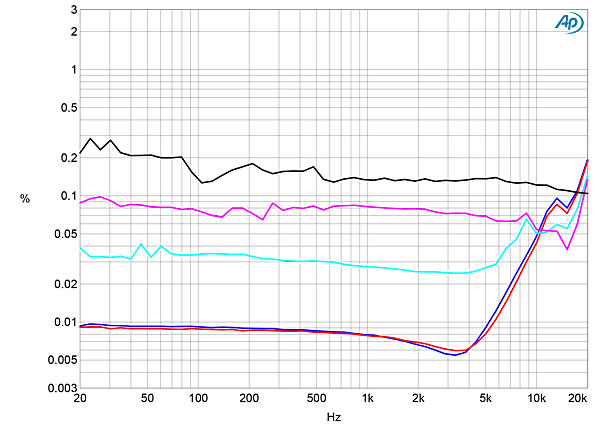
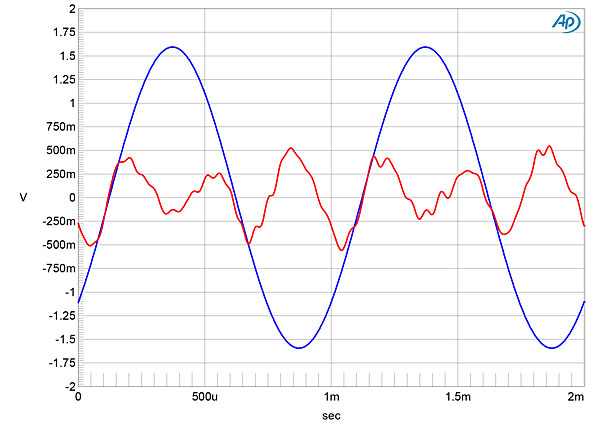
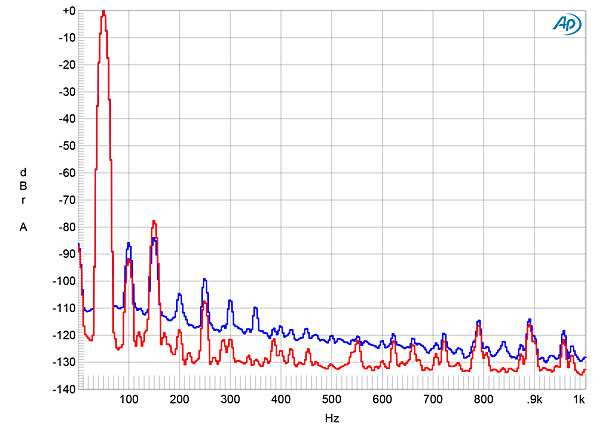
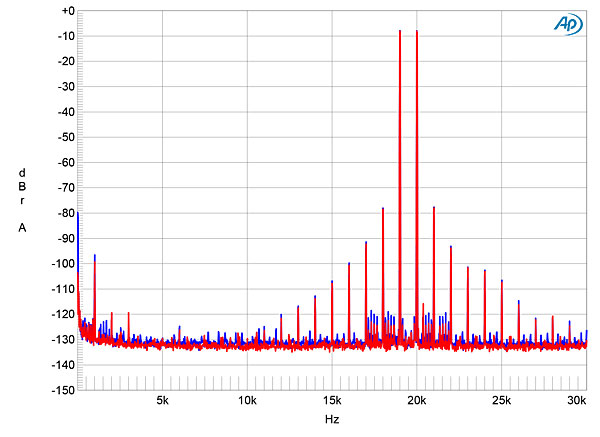
The ACI 600's phono input offers four different gains and a range of load impedances, all selectable with the onscreen menu. The gain, measured at the speaker terminals with the volume control set to "85," ranged from 60.4dB (suitable for moving-magnet cartridges) to 86.4dB (appropriate for low-output moving-coils). The RIAA error was vanishingly small (fig.13), though the highs and lows rolled off, respectively reaching –3dB at 35kHz and at 17Hz. Noise levels were low, and with the lowest gain setting, the unweighted, wideband S/N ratio was an okay 58dB, this improving to 71dB when A-weighted. The S/N ratio decreased as the gain was increased. Phono overload margins were good, at 15dB at 20Hz, 12dB at 1kHz, and 11dB at 20kHz. Harmonic and intermodulation distortion levels via the phono input were also respectably low (not shown).
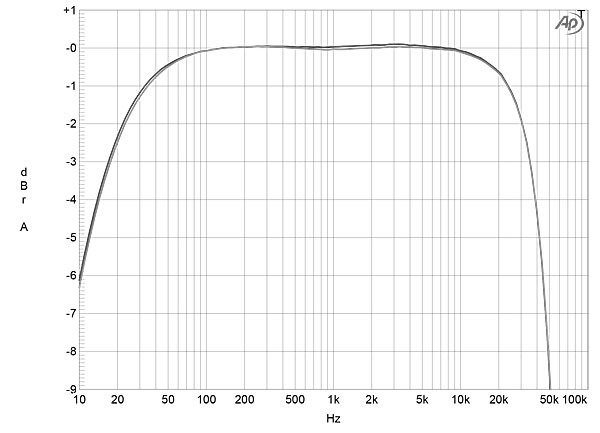
Turning to the Black ACI 600's behavior with digital data, I tested it using the Audio Precision's TosLink and coaxial S/PDIF and AES/EBU inputs, and repeated the tests with WAV and AIFF files sourced from Pure Music 3.0 running on my MacBook Pro via the ACI 600's USB-B input. Both S/PDIF inputs locked to datastreams with sample rates of up to 96kHz, the AES/EBU input up to 192kHz. The USB-B input accepted 16- and 24-bit integer data sampled up to 384kHz. However, while the front-panel display did show "384" with data sampled at that rate, the ACI 600's output remained muted. Apple's USB Prober utility identified the ACI 600 as "BELCANTO Hi-Res 2" from "XMOS," and that it operated in the optimal isochronous asynchronous mode.
With the ACI 600's volume control set to "85," a 1kHz tone at 0dBFS gave rise to an output of 21.26V from the speaker outputs, the latter equivalent to 56.5W into 8 ohms. Full-scale digital data didn't allow the amplifier to reach its full output, therefore; if the ACI 600 won't drive its owner's speakers to high enough levels with its default maximum volume-control setting of "85," the optional setting of "100" will add another 15dB.
The Bel Canto's impulse response with 44.1kHz data (fig.14) indicates that the reconstruction filter is a minimum-phase type, with all the ringing following the single sample at 0dBFS, but also that the digital inputs are inverted. With 44.1kHz-sampled white noise (fig.15, red and magenta traces), the ACI 600's response rolled off slowly above the Nyquist frequency, or half the sample rate (vertical green line). An alias at 25kHz of a full-scale tone at 19.1kHz (blue and cyan traces) is therefore attenuated by just 20dB. The ACI 600's reconstruction filter appears to be identical to the standard MQA filter in both the time and frequency domains, and Bel Canto's John Stronczer confirmed via e-mail that they use this filter not only with MQA but with all PCM data, because he feels it sounds best for all sources.
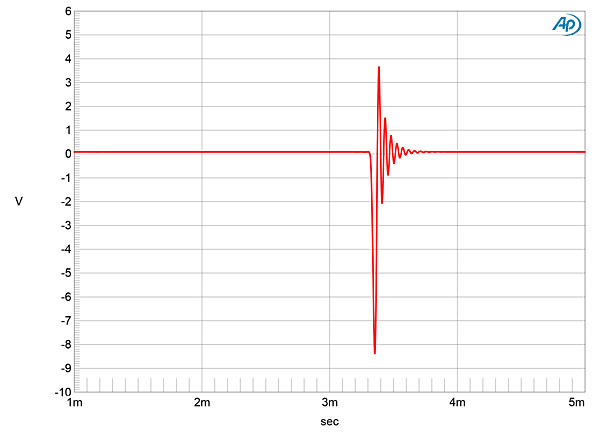

Fig.16 shows the ACI 600's digital frequency response with AES/EBU data sampled at 44.1kHz (gray and green traces), 96kHz (cyan, magenta), and 192kHz (blue, red). The response follows the same basic shape at all three sample rates, with a sharp rolloff just below each of the two lower Nyquist frequencies. With high-sample-rate data the digital response was dominated by the amplifier's ultrasonic rolloff. When the ACI 600 decoded dithered 16- and 24-bit data representing a 1kHz tone at –90dBFS, with the volume control set to "85" to minimize the effect of its selfnoise, the increase in bit depth dropped the noise floor by around 15dB (fig.17), which implies resolution of close to between 18 and 19 bits. With an undithered 16-bit tone at exactly–90.31dBFS (fig.18) the waveform was symmetrical, but the three DC voltage levels described by the data are overlaid by some high-frequency noise. With undithered 24-bit data (fig.19) the result was a fairly clean sinewave.
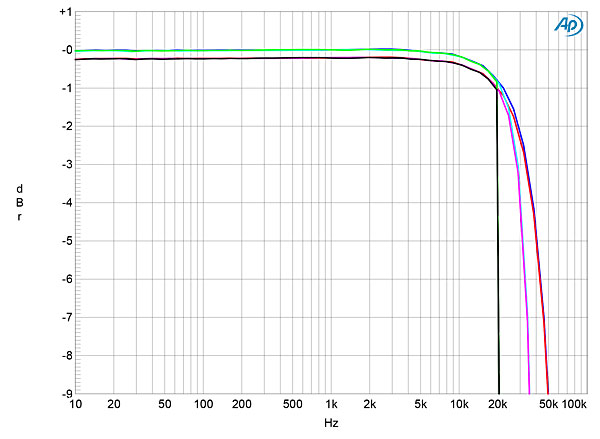
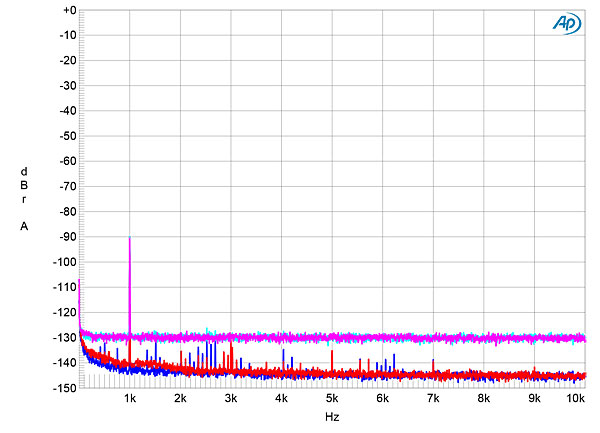
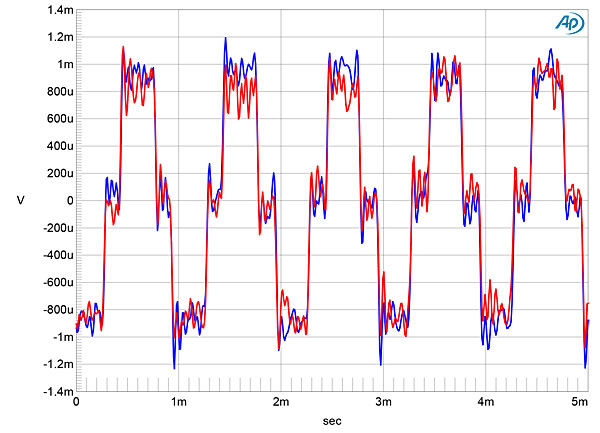
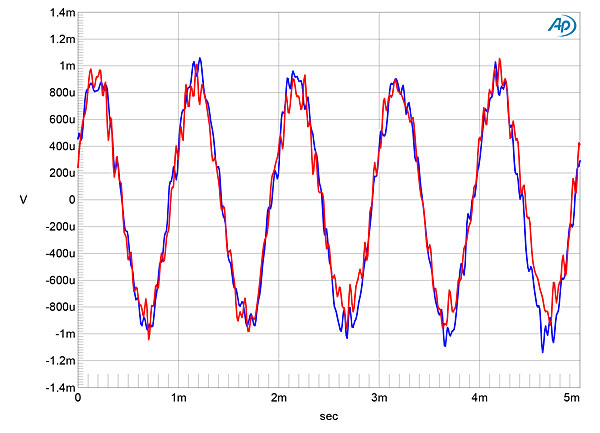
I tested the ACI 600's intermodulation distortion via its digital inputs with a signal comprising equal levels of 19 and 20kHz tones peaking at –3dBFS (fig.20) rather than my usual 0dBFS. This is because the MQA filter overloads with top-octave data above that level; in his e-mail, Stronczer explained that this was acceptable because real music, as opposed to test tones, never has high-level energy that high in frequency. The leaky nature of the filter allows aliased images of the tones to appear, but actual intermodulation distortion is very low in level. With 16-bit J-Test data (fig.21), all of the odd-order harmonics of the LSB-level, low-frequency squarewave are reproduced at the correct levels (slanting green line). However, a low-level pair of sidebands can be seen at ±120Hz.
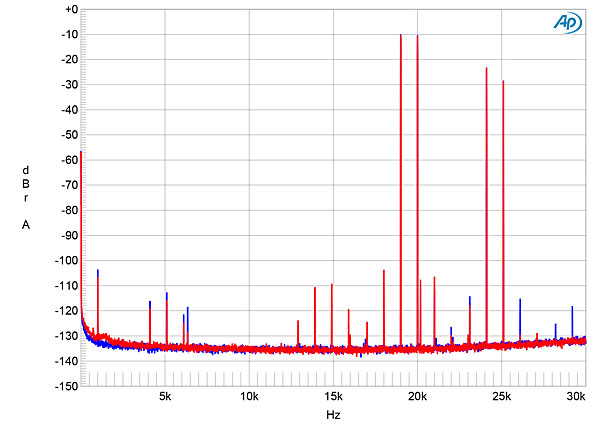
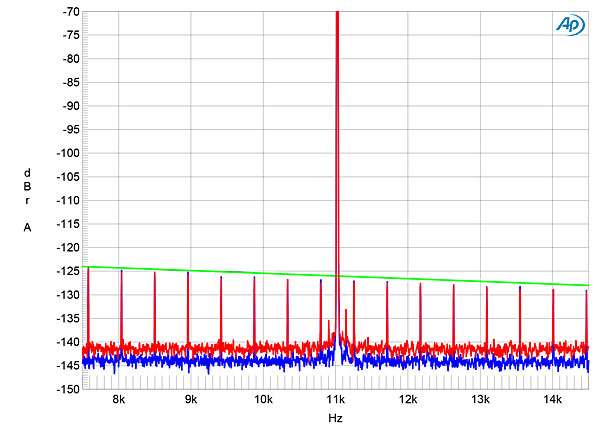
Bel Canto's Black ACI 600 packs high power and a lot of functionality into a small, elegant enclosure. Other than the problems I found with the headphone output and the inability to play data sampled at 384kHz via the USB-B input, both of which may be sample faults, it offers respectable measured performance.—John Atkinson

One choice of filter, the MQA? No chance to use another type of filter if you tend to prefer it, like a linear phase one?

Leaving the filter issue aside, you get a streamer, a phono stage, a DAC, preamp and power amp. I'm listening to one now on evaluation, comparing it to a 30K stack and it's quite good. Plus the savings in great cables is immense. Just sayin'...

Not exactly affordable, is it? And not a stellar performer either. The THD is way too high.

I've been doing this for 30 years and designing for longer. Maybe, just maybe, you can tell more about a piece by listening than by looking at one spec. I love what I do/I hate what I do...